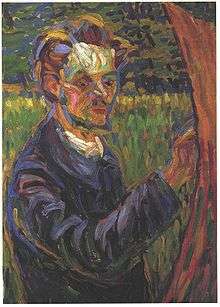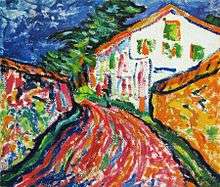Erich Heckel
Erich Heckel (31 July 1883 in Döbeln – 27 January 1970 in Radolfzell) was a German painter and printmaker, and a founding member of the group Die Brücke ("The Bridge") which existed 1905-1913. His work was part of the art competitions at the 1928 Summer Olympics and the 1932 Summer Olympics.[1]
Erich Heckel | |
|---|---|
 Erich Heckel painting at the easel – portrait by Ernst Ludwig Kirchner | |
| Born | July 31, 1883 |
| Died | January 27, 1970 (aged 86) |
| Nationality | German |
| Education | Königliche Technische Hochschule |
| Known for | Die Brücke |
| Style | Woodcuts/printmaking, painting |
| Movement | Expressionism |

Biography
Heckel was born in Döbeln, Saxony, the son of a railway engineer. Between 1843 and 1904 he attended the Realgymnasium in Chemnitz, before studying architecture in Dresden. He left after three terms, shortly after the foundation of Die Brücke, an artists' group of which he was secretary and treasurer.[2] The other founder-members, also architectural students, were Ernst Ludwig Kirchner, Karl Schmidt-Rotluff and Fritz Bleyl.[3] He worked in the office of the architect Wilhelm Kreis until July 1907, when he resigned to become a full-time artist.[2]
Career
Heckel met the other founding members of Die Brücke, Ernst Ludwig Kirchner, Karl Schmidt-Rotluff, and Fritz Bleyl, while studying architecture in Dresden. The foursome equally regarded pursuing a degree in architecture as a compromise with their respectable middle-class parents who would have never supported them, had they wanted to study art.[4] Heckel attended the Dresden Polytechnic Institute for only eighteen months, after which time he accepted a job as a draughtsman at Wilhem Kreis's architectural studio. He was able to use the position for the benefit of the Brücke. When the firm was asked to design an exhibition room for the lamp manufacturer Max Seifert, Heckel was able to persuade the industrialist that it was worthwhile giving wall space and displays to the Brucke for an exhibition.[5]
Art
As a member of Die Brücke, Heckel often filled the role of business manager, which allowed the collective to network with other upcoming artists at the time, such as the Munich-based Franz Marc. This subsequently led to greater publicity for the collective, such as their mention in the almanac of Franz Marc's own artistic coalition, the Blaue Reiter.[4]

It is worthwhile to note that with the exception of one favorable review by Paul Fetcher in the leading Dresden newspaper Dresdner Neueste Nachrichten, the exhibition in Löbtau at the factory of the lamp manufacturer Max Seifert was considered to be a flop. In addition, Heckel's poster, no longer extant, had been barred from public display by the Dresden police.[6] In 1906 and 1907 the Die Brücke had another exhibition in Löbtau, devoted exclusively to graphics and including a group of woodcuts by Wassily Kandinsky. Unfortunately, the group once again failed to strike a chord with the public.[6] However, much more noteworthy and ironically also notorious, were the next three annual shows by the Die Brücke, this time held in the fashionable Emil Richter Gallery. In large, silent rooms, expensively furnished and smothered with lush carpets, the group's unconventional paintings and prints struck a foreseeably strident chord, amongst them notably a nude poster of a woman that ruffled many a complacent Dresdener.[6]
Heckel and other members of Die Brücke greatly admired the work of Edvard Munch, and aimed to make a "bridge" between traditional neo-romantic German painting and modern expressionist painting. The four founding members made much use of the print as a cheap and quick medium with which to produce affordable art.
Primitive art was also an inspiration to the members of the Die Brücke. It was Heckel's brother who introduced the group to African sculpture, and it is noted that their acceptance of primitive art, which was to fortify decisively the expressive yearnings of European artists- Was unequivocal. It is through this style that they found a source of strength in the barbaric figures.[4]
World War I and II
In December 1911, Erich Heckel moved from Dresden to Berlin. Die Brücke was dissolved in 1913. He was classified as unfit for active service during the First World War, but volunteered to serve in an ambulance unit stationed in Belgium.[2] He managed to continue to produce work throughout the war.[2]
Between 1922 and 1924 Heckel painted one small, arched room at the invitation of the Angermuseum on the ground floor of the museum. It is now called the Heckelraum. The mural paintings, which were subsequently given the title Lebenstufen (in English: Stages in Life), are considered to be the most important surviving wall paintings of German Expressionism.
In 1937 the Nazi Party declared his work "degenerate"; it forbade him to show his work in public, and more than 700 items of his art were confiscated from German museums. By 1944 all of his woodcut blocks and print plates had been destroyed. After World War II Heckel lived at Gaienhofen near Lake Constance, teaching at the Karlsruhe Academy until 1955. He continued painting until his death at Radolfzell in 1970.
Legacy
Like most members of Die Brücke, he was a prolific printmaker: Dube's catalogues raisonné describe with 465 woodcuts, 375 etchings, and 400 lithographs. More than 200 of them, mostly etchings, are from the last seven years of his life.
A major retrospective exhibition, Erich Heckel – His Work in the 1920s, was held October 2004 – February 2005 at the Brücke Museum in Berlin.
In 2000, Heckel's Dangaster Dorflandschaft (Dangast village landscape) (1909) was sold for £1.21 million at Sotheby's in London.[7]
David Bowie based the cover of his 1977 album "Heroes" on Heckel's painting Roquairol.[8][9] The same painting also provided the basis for the cover of Iggy Pop's 1977 album The Idiot.[10]
Critical reception
The critic James Auer has said that Heckel's Franzi Standing ...
...in many ways encapsulates the principal virtues of the entire Expressionist movement. At once frank and respectful, daring and compassionate, it depicts a girl-woman on the cusp of adolescence, innocent and free yet, at the same time, curious and knowing.
References
- "Erich Heckel". Olympedia. Retrieved 27 July 2020.
- Carey, Frances; Griffiths, Anthony (1984). "Erich Heckel". The Print in Germany 1880–1933. London: British Museum Publications. p. 116. ISBN 0-7141-1621-1.
- "German Expressionist Chronology". Museum of Modern Art. Retrieved 22 October 2013.
- Roh, Franz (1958). German Art in the 20th Century. Munich: F. Bruckmann KG.
- Elger, Dietmar (1998). Expressionism. Taschen.
- Uhr, Horst (1982). Masterpieces of German Expressionism at the Detroit Institute of Arts. New York: Hudson Hills Press.
- Souren Melikian (October 28, 2000), Brokerages May Alter the Art Game : Earthquakes in the Auction World International Herald Tribune.
- "Heroes". bowiegoldenyears.com. Archived from the original on 5 October 2009. Retrieved 27 January 2017.
- Cascone, Sarah (12 January 2016). "Take a Peek at David Bowie's Idiosyncratic Art Collection". artnet.com. Retrieved 27 January 2017.
- Raul (22 December 2011). "Iggy Pop's "The Idiot" & David Bowie's "Heroes" Album Cover Photos Were Inspired By The Same Painting". feelnumb.com. Retrieved 27 January 2017.
External links
| Wikimedia Commons has media related to Erich Heckel. |
| Wikiquote has quotations related to: Erich Heckel |
- Heckel - Fränzi reclining
- Erich Heckel's 1920s work at the Brücke
- works of the artist at "Museumsportal Schleswig-Holstein"
- Available Works & Biography Galerie Ludorff, Düsseldorf, Germany